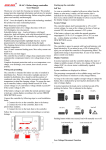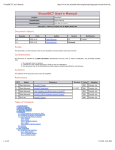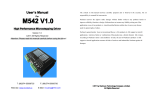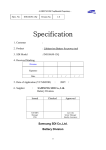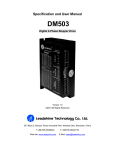Download SLAC-H Solar charge controller User Manual
Transcript
Battery Type SLAC-H Solar charge controller User Manual Factory Settings of the controller is to operate with lead-acid batteries with liquid electrolyte. If you intend to use a lead-acid battery with solid electrolyte(Gel type or AGM type), you can adjust the charging characteristics (see "Settings"). The equalization charge mode is canceled then. In case of any doubts or questions, please consult your dealer. Thank you very much for choosing our product. This product manual provides important information and advices for product installation, use and troubleshooting. Before using this product, please read carefully and thoroughly. Display Functions The controller is equipped with 5 LEDs and an acoustic warning signal. Our product has a number of safety and display functions. Clear readable LED display of the state of charge. Acoustic signal when the state of charge changes. Low voltage disconnect regulated by state of charge or voltage. The controller adjusts itself automatically to 12V or 24V system voltage. Max .16 mm² connector binding posts. Max safety current can reach 91A. The charging characteristics include automatic adoption to the ambient temperature. Complete electronic protection. State of charge LED Charge LED Load status LED Wiring and grounding: The controller is intended for indoor use only or installed in distribution box. Protect it from direct sunlight and rain. If installed in distribution box, should avoid the position of condensed water drip. The controller measures the ambient temperature to adapt the charging voltage. To ensure the start-up of controller, battery voltage should exceed 10V if the system voltage is 12V, and battery voltage should exceed 20V if the system voltage is 24V. Charge display Solar array supplies electricity Green LED on If the battery voltage is not within the normal operation range at start-up, a status display according to the section ERROR DESCRIPTION occurs. Solar array does not supply electricity Green LED off State of charge display Connect the controller by following steps to avoid installation faults. 1. Connect the wire to the controller, then to the battery. 2. Connect the wire to the controller, then to the photovoltaic modules. 3. Connect the wire to the load, then to the controller. A change of the state of charge (SOC) to a lower status is indicated by an acoustic signal. 80%-100% High Follow the reverse procedure when uninstalling to avoid any damage. 30%-80% Medium 10%-30% Low <10% Very low Bottom Yellow Top Yellow Middle Yellow Bottom Yellow LED flash LED on LED on LED on The loads are disconnected approx. 1 minute after a series of 25 tones. (2) (1) Load status display (3) In case of deep discharge or overload/short-circuit of load, the load output is switched off. This is indicated by followings: All positive connections of SLAC-H controller are common and therefore have the same electrical potential. If any grounding is required, always do this on the positive wire. Special grounding terminal can be used for controller shell grounding. If the controller is used in a vehicle which has the battery negative on the chassis, loads connected to the controller must not have an electric connection to the car body. Otherwise the Low Voltage Disconnect function and the electronic fuse function of the controller are short circuited. Normal operation Red LED off REMARK: Mind the recommendations of your battery manufacturer. We strongly recommend connect a fuse directly to the battery to protect any short circuit at the battery wiring. The fuse must correspond to 1.5 times the nominal current of the controller. LVD protection Red LED on Low Voltage Disconnect Function Overload or over temperature or short circuit Red LED flash To protect the battery from being deeply discharged, the controller has following 2 protection modes: Starting up the controller: 1. State of charge controlled (SOC) : Disconnect at 11.4V/22.8V (at rated load current) up to 11.9V/23.8 V(At no load current). Factory default mode for better safe battery protection. Self Test As soon as the controller is supplied with power from the battery, it starts a self test routine. Then the display changes to normal operation. 2. The battery voltage controlled (LVD): Disconnect at 11.0V/22.0 V fixed voltage settings. The controller adjusts itself automatically to 12V or 24V system. As soon as the voltage at the time of start-up exceeds 20V, the controller assumes a 24V system. Setting After opened the case of controller, there are three jumpers can be seen on circuit broad: GEL LVD BUZ. The factory setting is Jumper OFF. If the battery voltage is not within the normal operation range at start-up, a status display according to the section ERROR DESCRIPTION occurs. 1 Jumper ON Jumper OFF With these jumpers, the following settings can be configured: Jumper GEL LVD BUZ Function Battery type Function of low voltage disconnect Acoustic alarm signal Jumper OFF Flooded battery State of charge controlled Alarm off Jumper ON Factory setting GEL (VRLA battery) Flooded battery Voltage controlled State of charge controlled flashing Alarm on Alarm on Over temperature protect Cool down the controller. Load will be switched on automatically. Battery voltage too high Check if other sources overcharge the battery. If not, controller is damaged. Battery wire or the fuse is Check the battery, damaged, the fuse and the battery has high wire. Remove faults. resistance. Battery power is low after a short time. Battery capacity becomes very low. Replace the battery. Battery is not being charged during daytime. Solar panels faulty or reverse polarity (green LED off) Check the solar panel and wire. Remove faults. Battery wrong polarity. All LEDs Battery is off. Buzzer connected with alarm reverse polarity. warning. Change polarity. Safety features: SLAC – H safety features can protect the controller to avoid damage to products due to incorrect installation or use. PV terminals Reverse polarity Battery terminals Protected(Not at Protected (buzzer 24V system alarm warning) voltage.) Load terminals Protected (1) Short circuit Protected (2) Protected(3) (with fuse on battery) Switches off immediately(2) Over current Controller will limit the current. Protected Switches off with a delay (4) Reverse charge Protected No effect No effect Over voltage Max. 55V Max. 55V Switches off above 15.5V/31.0 V Under voltage No effect Switches off load Switches off SLAC-H Technical Characteristics Model Rated system voltage Rated battery charging current Boost charge Equalization When over temperature occurs, the controller will limit the charging current. If the temperature of controller reaches a high level, the load will automatically be switched off. (1) Controller can protect itself, but load might be damaged. (2) Short circuit current: >4x—6x nominal current, <300 A. (3) We strongly recommend that add a fuse between battery and controller. The battery may be permanently damaged when short circuit occurs. (4) > 200% rated current: Load will be switched off with 3s delay. Float charge Deep discharge protection, cut-off voltage. Reconnect level Under voltage protection. Over voltage protection. Max. Charge current. Max. Load current. Over temperature Self consumption Warning: Two or more error conditions at the same time may cause damage to the controller. Always remove the present fault condition before next operation. Max. Panel/ Battery voltage Temperature compensation (Charge voltage) Grounding Battery type Dimensions (WxHxD) Installation dimensions Max. wire size Ambient temperature IP grade Altitude Net weight Troubleshooting Error Loads are not supplied Indication Cause Corrective action Battery is low (Red LED on) Load will reconnect as soon as battery is recharged. Over current or short circuit (Red LED flashing) Switch off all loads. Remove all errors. Controller will switch on load automatically after max 1 minute. Subject to change without notice. Version: 20140530 Made in China www.upnetech.com 2 SLAC-H 10A/20A/30A/40A 12V/24V auto recognition 10A 20A 30A 40A 14.5V / 29V(25 °C) 2 h Activation: battery voltage < 12.3/24.6 V 14.8V/29.6(25 °C) 2 h Activation: battery voltage < 12.1/24.2 V (at least one time every 30 days) 13.8V / 27.6V(25 °C) 11.4-11.9V/22.8-23.8 V by SOC 11.0/22.0 V by voltage 12.8V/25.6V 10.8V/21.6V 15.5V/31.0 V 10A 20A 30A 40A 10A 20A 30A 40A 4mA-5mA(12V) 5mA-6mA(24V) 55V -25 mV/K (12 V system) -50 mV/K (24 V system) Positive grounding Lead acid (GEL, AGM, flooded) 140mm*72mm *40mm 130mm*66mm Max 16mm² -40°C-+60°C IP22 ≤4000m 280g



